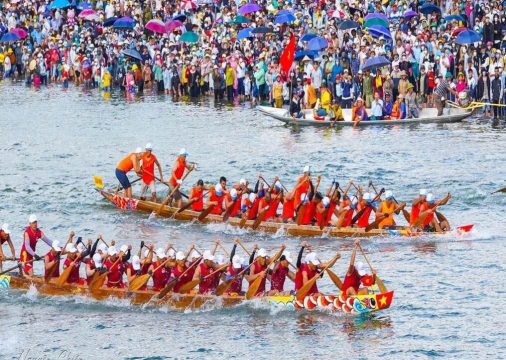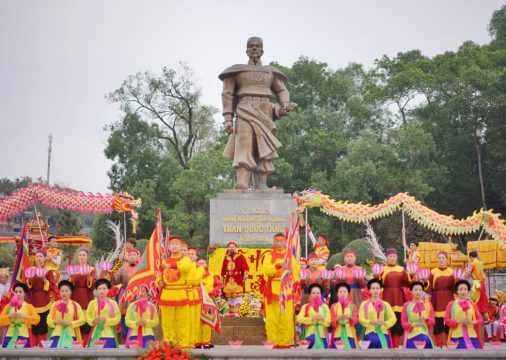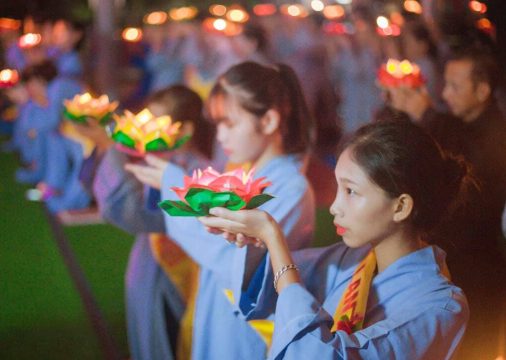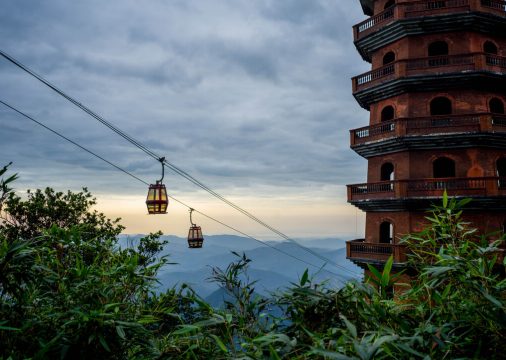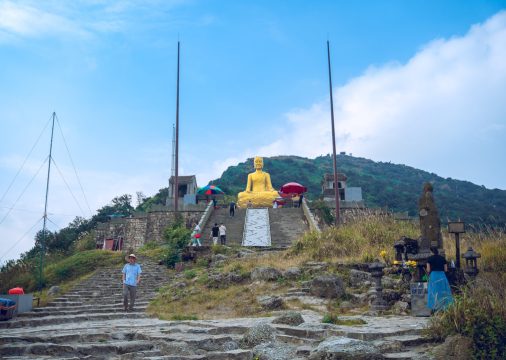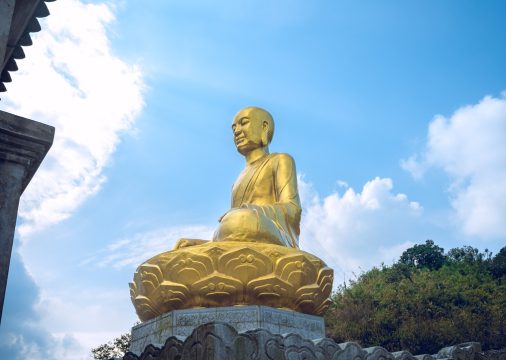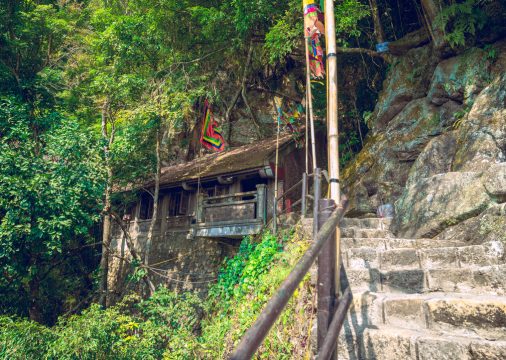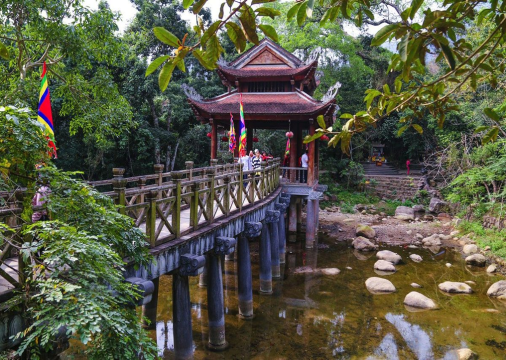Complete Prayer Guide for Visiting Yen Tu Pagoda: Rituals, Offerings & Tips
Prayer Offerings When Visiting Yen Tu Pagoda are an essential part of the pilgrimage, allowing Buddhists to express their devotion when visiting the sacred Yen Tu Pagoda. In the article below, Yen Tu Tung Lam presents six of the most accurate and appropriate prayer offerings for key stops along the spiritual journey at Yen Tu – the birthplace of the Truc Lam Zen sect.
1. Introduction to Yen Tu Pagoda, Quang Ninh
Located in Quang Ninh Province, Yen Tu Pagoda is among the most sacred and renowned religious sites in Vietnam. This historical complex sits atop Yen Tu Mountain and includes ancient pagodas, stupas, and centuries-old forests. It became a pivotal center of Buddhism after King Tran Nhan Tong abdicated the throne, donned a monk’s robe, and founded the Truc Lam Zen sect at Yen Tu.
Yen Tu Pagoda symbolizes Vietnamese Buddhism, as King Tran Nhan Tong chose spiritual renunciation over royal life. He established the unique Vietnamese Zen school – Truc Lam Yen Tu – and became its first patriarch under the dharma name Dieu Ngu Giac Hoang Tran Nhan Tong (1258–1308). Under his guidance, hundreds of spiritual structures were built on Yen Tu Mountain for meditation, scripture teaching, and Buddhist practice.
Deities worshiped at Yen Tu Pagoda:
- Mot Mai Pagoda: Worships the Three Patriarchs of Truc Lam, the Buddha, and the Mother Goddess
- Am Ngu Duong and Am Thung: Places where King Buddha Tran Nhan Tong once prepared herbal medicine
- Bao Sai Pagoda: Where his close disciples practiced and compiled Truc Lam scriptures

2. Full Collection of Prayer Offerings at Yen Tu Pagoda
Prayer rituals at Yen Tu Pagoda should be performed respectfully and correctly. Below is a compilation of the most important prayer offerings at Yen Tu Pagoda to help ensure a sincere and proper worship experience.
2.1 Prayer to the Buddha
This is the standard prayer for worshipping Buddha at Yen Tu Pagoda, usually performed at the main hall. It honors Shakyamuni Buddha, Amitabha Buddha, and the Buddhas of the ten directions. This prayer expresses repentance, a vow to do good, and wishes for peace for one’s family and loved ones.

2.2 Prayer for Wealth and Peace at the Tam Bao Altar
Used especially at the Tam Bao (Three Jewels) altar, this prayer honors Amitabha Buddha, Shakyamuni Buddha, Medicine Buddha, and Avalokitesvara Bodhisattva. It is often recited to wish for health, prosperity, and peace for one’s family.

2.3 Prayer to Avalokitesvara Bodhisattva
Dedicated to Avalokitesvara Bodhisattva (Quan The Am), this prayer reflects faith in the compassion of the Bodhisattva, praying for blessings, health, and support during hardships.

2.4 Prayer to the Virtuous Saints
This short yet meaningful prayer is offered to Ananda – a key disciple of Buddha – to seek blessings, health, and prosperity from the virtuous saints.

2.5 Prayer to Ksitigarbha Bodhisattva
This prayer, recited at the Cuu Hoa shrine within Yen Tu Pagoda, seeks the compassionate support of Ksitigarbha Bodhisattva – for oneself and the souls of departed ancestors. It’s particularly meaningful for memorial and ancestral rites.

2.6 Prayer to the Holy Guardian – Duc Ong
This is the initial prayer offered at the temple’s Duc Ong shrine – honoring Tu Dat Ton Gia, a guardian of sacred Buddhist grounds. Traditionally, this prayer is performed first upon entering the temple, asking for protection and blessings.

3. Tips for Visiting Yen Tu Pagoda
To fully enjoy a spiritual journey to Yen Tu Pagoda, keep in mind several important tips regarding timing, offerings, and rituals. These insights are shared by experienced pilgrims who’ve visited this sacred destination.
3.1 Best Time to Visit Yen Tu
The most auspicious time for pilgrimage and worship at Yen Tu Pagoda is from the 10th day of the first lunar month to the end of the third lunar month. During this period, the area receives the most pilgrims. The sacred and solemn atmosphere makes it ideal for prayer and spiritual reflection.
[caption id="attachment_6487" align="aligncenter" width="800"] The best time for pilgrimage to Yen Tu is from the 10th day of the first lunar month to the end of the third.
The best time for pilgrimage to Yen Tu is from the 10th day of the first lunar month to the end of the third.
3.2 Preparing Offerings
When preparing offerings for Yen Tu Pagoda, follow these strict customs:
- Use vegetarian offerings: Incense, fresh flowers, ripe fruits, sticky rice, and vegan cakes
- Animal offerings are only permitted at altars dedicated to Saints, Holy Mothers, or Duc Ong
- Main sanctuaries (Buddha altars): Only accept vegetarian offerings – absolutely no meat
- No ghost money or votive paper: These are not appropriate for Buddha altars and should only be placed at altars for saints or deities
- Real money: Should not be placed on altars, but instead donated into temple offering boxes
3.3 How to Perform the Worship Ritual
To perform a proper worship ritual at Yen Tu, follow these steps:
- Start at the Duc Ong altar: Present offerings, light incense, and pray first at this altar
- Proceed to the main sanctuary: Place offerings on the main altar and worship the Buddhas and Bodhisattvas
- Pray at each shrine: Offer incense and perform 3 or 5 prostrations at each place
- Visit the Holy Mother and Four Palaces shrines: If present, offer incense and prayers as per your wishes
- Pay respects at the Patriarch Hall (Hau Hall)
- Complete the ritual with gratitude: Visit the guest house or monks’ quarters to express thanks and make merit
3.4 What You Should and Should Not Pray For
Below is a table outlining appropriate and inappropriate wishes:
| What You Should Pray For | What You Should Not Pray For |
| National peace and prosperity | Do not make conditional promises to the Buddhas (e.g., “If I succeed, I will donate…”) |
| Family health and harmony | Do not specify exact times or amounts for future offerings (e.g., gold or rice) |
| Clarity of mind and virtuous thoughts | Do not pray for favors in all three realms (heaven, earth, and underworld) |
| Intelligence and success for children | Avoid praying for material wealth – Buddhism does not grant such requests |
| Family prosperity and peace | |
| Work success and good karma | |
| Merit dedication for the deceased and for all sentient beings |
4. Important Notes When Visiting Yen Tu
To ensure a safe and fulfilling pilgrimage to Yen Tu, please keep the following notes in mind:
- Carry only necessary cash: Avoid bringing large sums of money to reduce the risk of loss or theft in crowded areas
- Wear proper footwear: The journey to the summit is long and steep – hiking shoes are best
- Bring water: Services are often expensive on-site; bring your own water to stay hydrated
- Dress appropriately: As a sacred spiritual destination, wear modest, respectful clothing that’s also suitable for trekking

Performing the proper prayer offerings at Yen Tu Pagoda and following these guidelines will help ensure a meaningful and complete spiritual experience. Yen Tu Tung Lam hopes these insights prove helpful for your pilgrimage to Yen Tu.








